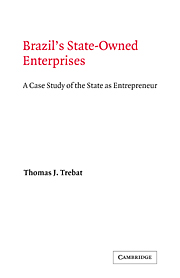Book contents
- Frontmatter
- Contents
- List of tables and figures
- Preface
- 1 Introduction
- 2 The economic role of the state
- 3 Origins of public enterprise in Brazil
- 4 The control of public enterprise in Brazil
- 5 Relationships with economic growth
- 6 Sources of growth and rates of return
- 7 Policies on pricing
- 8 The financing of public enterprise investment
- 9 Conclusions
- Appendix A Enterprises included and years covered
- Appendix B Sources and interpretation of data on public enterprises, 1965–1979
- Notes
- Selected bibliography
- Index
- Cambridge Latin American Studies
Appendix B - Sources and interpretation of data on public enterprises, 1965–1979
Published online by Cambridge University Press: 27 March 2010
- Frontmatter
- Contents
- List of tables and figures
- Preface
- 1 Introduction
- 2 The economic role of the state
- 3 Origins of public enterprise in Brazil
- 4 The control of public enterprise in Brazil
- 5 Relationships with economic growth
- 6 Sources of growth and rates of return
- 7 Policies on pricing
- 8 The financing of public enterprise investment
- 9 Conclusions
- Appendix A Enterprises included and years covered
- Appendix B Sources and interpretation of data on public enterprises, 1965–1979
- Notes
- Selected bibliography
- Index
- Cambridge Latin American Studies
Summary
Introduction
A major impediment to the study of public enterprise performance in Latin America has been the lack of central data files. The creation of SEST – the federal budgetary authority – in 1979, was the beginning of a major step forward in resolving this problem in the case of Brazil, but no comparable data collection point existed during the time period covered by this study. Consequently, one of the most important tasks for the researcher is to marshal comparable data on numerous public enterprises in different economic sectors. The purpose of this appendix is to describe briefly the attempts made to surmount this difficulty in the case of Brazilian public enterprises from 1965 to 1979.
First, the most important sources of data on public enterprise performance are described. Second, the methods for classifying the bulk of raw financial data underlying this study are set forth. Third, the methods used to derive a number of the more important variables used in this study are described.
Sources of data on public enterprise performance, 1965–79
The principal sources of data used in this study included: (1) annual reports of public firms, holding companies, ministries, and ministerial bodies; (2) data files of the Centro de Estudos Fiscais, Fundac,ao Getulio Vargas; (3) miscellaneous publications and internal documents of individual enterprises or similar works relating to particular industries in which public enterprises are dominant; (4) annual surveys of the financial condition of enterprises; (5) interviews with government officials and directors of public firms; (6) newspaper files, primarily those of O Estado de São Paulo; and (7) reports of the Secretary for the Control of State Enterprises (SEST).
- Type
- Chapter
- Information
- Brazil's State-Owned EnterprisesA Case Study of the State as Entrepreneur, pp. 248 - 254Publisher: Cambridge University PressPrint publication year: 1983



